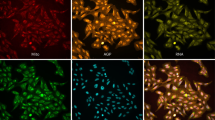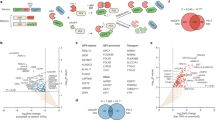Abstract
The centrosome is the major microtubule-organizing centre of animal cells and through its influence on the cytoskeleton is involved in cell shape, polarity and motility. It also has a crucial function in cell division because it determines the poles of the mitotic spindle that segregates duplicated chromosomes between dividing cells1,2,3,4,5. Despite the importance of this organelle to cell biology and more than 100 years of study, many aspects of its function remain enigmatic and its structure and composition are still largely unknown. We performed a mass-spectrometry-based proteomic analysis of human centrosomes in the interphase of the cell cycle by quantitatively profiling hundreds of proteins across several centrifugation fractions. True centrosomal proteins were revealed by both correlation with already known centrosomal proteins and in vivo localization. We identified and validated 23 novel components and identified 41 likely candidates as well as the vast majority of the known centrosomal proteins in a large background of nonspecific proteins. Protein correlation profiling permits the analysis of any multiprotein complex that can be enriched by fractionation but not purified to homogeneity.
This is a preview of subscription content, access via your institution
Access options
Subscribe to this journal
Receive 51 print issues and online access
$199.00 per year
only $3.90 per issue
Buy this article
- Purchase on Springer Link
- Instant access to full article PDF
Prices may be subject to local taxes which are calculated during checkout



Similar content being viewed by others
References
Bornens, M. Centrosome composition and microtubule anchoring mechanisms. Curr. Opin. Cell Biol. 14, 25–34 (2002)
Doxsey, S. Re-evaluating centrosome function. Nature Rev. Mol. Cell Biol. 2, 688–698 (2001)
Nigg, E. A. Centrosome aberrations: cause or consequence of cancer progression? Nature Rev. Cancer 2, 815–825 (2002)
Hinchcliffe, E. H. & Sluder, G. ‘It takes two to tango’: understanding how centrosome duplication is regulated throughout the cell cycle. Genes Dev. 15, 1167–1181 (2001)
Rieder, C. L., Faruki, S. & Khodjakov, A. The centrosome in vertebrates: more than a microtubule-organizing center. Trends Cell Biol. 11, 413–419 (2001)
Aebersold, R. & Mann, M. Mass spectrometry-based proteomics. Nature 422, 198–207 (2003)
Wigge, P. A. et al. Analysis of the Saccharomyces spindle pole by matrix-assisted laser desorption/ionization (MALDI) mass spectrometry. J. Cell Biol. 141, 967–977 (1998)
Bornens, M. & Moudjou, M. Studying the composition and function of centrosomes in vertebrates. Methods Cell Biol. 61, 13–34 (1999)
Kellogg, D. R., Moritz, M. & Alberts, B. M. The centrosome and cellular organization. Annu. Rev. Biochem. 63, 639–674 (1994)
Pietromonaco, S. F., Seluja, G. A., Aitken, A. & Elias, L. Association of 14-3-3 proteins with centrosomes. Blood Cells Mol. Dis. 22, 225–237 (1996)
Lange, B. M., Bachi, A., Wilm, M. & Gonzalez, C. Hsp90 is a core centrosomal component and is required at different stages of the centrosome cycle in Drosophila and vertebrates. EMBO J. 19, 1252–1262 (2000)
Brown, C. R., Doxsey, S. J., Hong-Brown, L. Q., Martin, R. L. & Welch, W. J. Molecular chaperones and the centrosome. A role for TCP-1 in microtubule nucleation. J. Biol. Chem. 271, 824–832 (1996)
Gergely, F. et al. The TACC domain identifies a family of centrosomal proteins that can interact with microtubules. Proc. Natl Acad. Sci. USA 97, 14352–14357 (2000)
Gascard, P. et al. Characterization of multiple isoforms of protein 4.1R expressed during erythroid terminal differentiation. Blood 92, 4404–4414 (1998)
Casenghi, M. et al. Polo-like kinase 1 regulates Nlp, a centrosome protein involved in microtubule nucleation. Dev. Cell 5, 113–125 (2003)
Chang, P. & Stearns, T. Delta-tubulin and epsilon-tubulin: two new human centrosomal tubulins reveal new aspects of centrosome structure and function. Nature Cell Biol. 2, 30–35 (2000)
Klotz, C. et al. Parthenogenesis in Xenopus eggs requires centrosomal integrity. J. Cell Biol. 110, 405–415 (1990)
Nakagawa, Y., Yamane, Y., Okanoue, T. & Tsukita, S. Outer dense fiber 2 is a widespread centrosome scaffold component preferentially associated with mother centrioles: its identification from isolated centrosomes. Mol. Biol. Cell 12, 1687–1697 (2001)
Popovici, C. et al. The t(6;8)(q27;p11) translocation in a stem cell myeloproliferative disorder fuses a novel gene, FOP, to fibroblast growth factor receptor 1. Blood 93, 1381–1389 (1999)
Hearn, T. et al. Mutation of ALMS1, a large gene with a tandem repeat encoding 47 amino acids, causes Alström syndrome. Nature Genet. 31, 79–83 (2002)
Collin, G. B. et al. Mutations in ALMS1 cause obesity, type 2 diabetes and neurosensory degeneration in Alström syndrome. Nature Genet. 31, 74–78 (2002)
Romio, L. et al. OFD1, the gene mutated in oral–facial–digital syndrome type 1, is expressed in the metanephros and in human embryonic renal mesenchymal cells. J. Am. Soc. Nephrol. 14, 680–689 (2003)
Lamond, A. I. & Mann, M. Cell biology and the genome projects—a concerted strategy for characterizing multi-protein complexes using mass spectrometry. Trends Cell Biol. 7, 139–142 (1997)
Mayor, T., Stierhof, Y. D., Tanaka, K., Fry, A. M. & Nigg, E. A. The centrosomal protein C-Nap1 is required for cell cycle-regulated centrosome cohesion. J. Cell Biol. 151, 837–846 (2000)
Ohta, T. et al. Characterization of Cep135, a novel coiled-coil centrosomal protein involved in microtubule organization in mammalian cells. J. Cell Biol. 156, 87–99 (2002)
Pfannenschmid, F. et al. Chlamydomonas DIP13 and human NA14: a new class of proteins associated with microtubule structures is involved in cell division. J. Cell Sci. 116, 1449–1462 (2003)
Kenedy, A. A., Cohen, K. J., Loveys, D. A., Kato, G. J. & Dang, C. V. Identification and characterization of the novel centrosome-associated protein CCCAP. Gene 303, 35–46 (2003)
Chen, Z., Indjeian, V. B., McManus, M., Wang, L. & Dynlacht, B. D. CP110, a cell cycle-dependent CDK substrate, regulates centrosome duplication in human cells. Dev. Cell 3, 339–350 (2002)
Yang, J. et al. Rootletin, a novel coiled-coil protein, is a structural component of the ciliary rootlet. J. Cell Biol. 159, 431–440 (2002)
Kilmartin, J. V. Sif1p has conserved centrin-binding sites and an essential function in building yeast spindle pole body duplication. J. Cell Biol. 162, 1211–1221 (2003)
Acknowledgements
We thank members of the Center for Experimental BioInformatics (CEBI) and the Nigg group for critical reading of the manuscript and fruitful discussions and M. Matzner for excellent technical support. We also thank M. J. Pebusque (INSERM U119, Marseille, France) for the kind gift of a cDNA clone of FOP. CEBI is supported by a grant by the Danish Natural Research Foundation. E.A.N. acknowledges support from the Max-Planck Society and the ‘Fonds der Chemischen Industrie’.
Author information
Authors and Affiliations
Corresponding authors
Ethics declarations
Competing interests
The authors declare that they have no competing financial interests.
Rights and permissions
About this article
Cite this article
Andersen, J., Wilkinson, C., Mayor, T. et al. Proteomic characterization of the human centrosome by protein correlation profiling. Nature 426, 570–574 (2003). https://doi.org/10.1038/nature02166
Received:
Accepted:
Issue Date:
DOI: https://doi.org/10.1038/nature02166
This article is cited by
-
The centrosomal protein 131 participates in the regulation of mitochondrial apoptosis
Communications Biology (2023)
-
Proteome census upon nutrient stress reveals Golgiphagy membrane receptors
Nature (2023)
-
Appearing and disappearing acts of cilia
Journal of Biosciences (2023)
-
De novo MCM6 variants in neurodevelopmental disorders: a recognizable phenotype related to zinc binding residues
Human Genetics (2023)
-
CCHCR1-astrin interaction promotes centriole duplication through recruitment of CEP72
BMC Biology (2022)
Comments
By submitting a comment you agree to abide by our Terms and Community Guidelines. If you find something abusive or that does not comply with our terms or guidelines please flag it as inappropriate.



